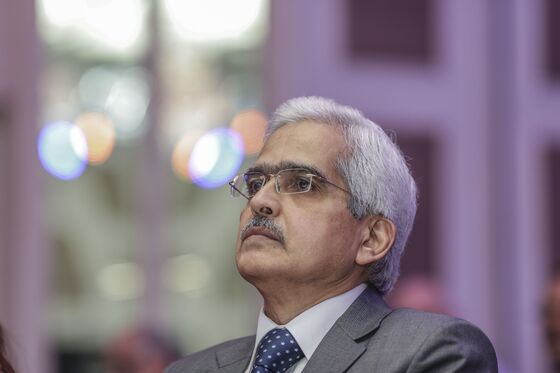India’s Central Bank Chief Sees Room for Rate Cut
The RBI has cut interest rates four times this year to spur growth from a six-year low.
(Bloomberg) -- India’s central bank Governor Shaktikanta Das said there’s room for interest rate cuts to spur economic growth given stable and below-target inflation.
Speaking at the Bloomberg India Economic Forum in Mumbai on Thursday, Das said a surge in oil prices following the supply disruption at a Saudi Arabian crude facility will likely be contained and won’t pose a major challenge to monetary policy or inflation.
“Today, when we see that price stability is maintained and our inflation is well below 4%, and is expected to be so in the next 12 months horizon, there is room for rate cut especially when growth has slowed,” he said.
He said the Monetary Policy Committee will take the final decision.
“Within this policy framework, the MPC will consider these aspects, as well as several other factors, including the assessment of growth and inflation projections of our research teams,” he said. “The final decision will be taken in the ensuing MPC meetings in October 2019.”
Sovereign Indian bonds gained Friday, with the yield on benchmark 10-year debt falling by 6 basis points to 6.58%. The rupee rose 0.3% to 71.0825 per dollar.
Das has maintained that reviving growth in Asia’s third-largest economy is his priority, with the Reserve Bank of India already cutting rates four times this year to spur growth from a six-year low. At the same time, policy makers are grappling with headwinds from volatile oil prices to a U.S.-China trade war.

“As long as oil remains in this range, I don’t think this is a big issue so far as price stability is concerned,” Das said, referring to oil prices that have pared gains to trade at around $65 a barrel. “As things stand today, it doesn’t seem to pose a challenge to inflation.”
India imports 80% of its oil needs and a sustained rise in costs would widen the nation’s current account deficit and put its currency, already among Asia’s worst performing this year, under more pressure.
The Federal Reserve‘s interest rate cut this week will help spur inflows to emerging markets, which the RBI will monitor closely in India, Das said.
“Central banks around the world are bracing to counter slowing growth with easing of monetary policy,” Das said.
Teresa John, an economist at Nirmal Bang Equities Pvt. in Mumbai, read Das’s comments as a signal for a rate cut of as much as 25 basis points next month.
“I don’t see the oil shock keeping prices high for long given the scenario of weak demand,” said John. “It seems pretty evident that he wants to cut in line with what global central banks are doing.”
The government has announced a number of measures in recent weeks to spur the economy, such as support for exporters and the housing sector, but those have mainly fallen short of expectations. Das said there will likely be more steps by the government to spur the economy, though fiscal space was “limited.”
Das also made the following comments at the summit:
Currency
The International Monetary Fund’s estimates the rupee is fairly valued and in line with the economy’s fundamentals. “We have no target or band for the exchange rate,” he said. “Interventions are intended merely to manage volatility.”
Fed
“This round of Fed cut was largely expected by the markets,” he said. “The coming months will tell what will be the stance of the U.S. Any cut would mean greater flows to India. This should lead to more inflow of funds to India through FPI and also FDI.”
“We have to be very careful to monitor these inflows and keep watch for any possible spillover effects, to ensure there is no asset buildup.”
Growth Outlook
The central bank is currently working on its inflation and GDP projections, and Das wouldn’t say if the RBI would lower its fiscal year growth forecast from 6.9%.
“On the fiscal side the government has by and large remained prudent, they have not announced any counter-cyclical measures,” he said. “Most of the measures relate to policy and administrative issues that were impediments.”
Fiscal Policy
“If you look at government borrowing together with public sector borrowing, there is little fiscal space.”
“There is little space for any fiscal expansion. It is important to do policy changes, focusing on ease of doing business, and structural reforms.”
Banks and Liquidity
“We will ensure there is adequate liquidity in the system for the needs of the economy.”
The bank “merger process will have to be non-disruptive, it’s essential to ensure the normal functions of the banks continue without disruption.”
“We will do our best to ensure credit flow and recovery of loans is not affected.”
--With assistance from Subhadip Sircar, Unni Krishnan and Kartik Goyal.
To contact the reporters on this story: Anirban Nag in Mumbai at anag8@bloomberg.net;Suvashree Ghosh in Mumbai at sghosh186@bloomberg.net;Ronojoy Mazumdar in Mumbai at rmazumdar7@bloomberg.net
To contact the editors responsible for this story: Nasreen Seria at nseria@bloomberg.net, ;Jeanette Rodrigues at jrodrigues26@bloomberg.net, Karthikeyan Sundaram
©2019 Bloomberg L.P.